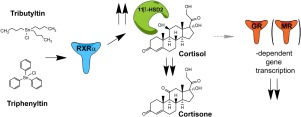当前位置:
X-MOL 学术
›
Toxicol. Lett.
›
论文详情
Our official English website, www.x-mol.net, welcomes your
feedback! (Note: you will need to create a separate account there.)
Tributyltin and triphenyltin induce 11β-hydroxysteroid dehydrogenase 2 expression and activity through activation of retinoid X receptor α
Toxicology Letters ( IF 2.9 ) Pub Date : 2020-04-01 , DOI: 10.1016/j.toxlet.2020.01.001 Silvia G Inderbinen 1 , Roger T Engeli 1 , Simona R Rohrer 1 , Erminio Di Renzo 2 , Leonie Aengenheister 2 , Tina Buerki-Thurnherr 2 , Alex Odermatt 1
Toxicology Letters ( IF 2.9 ) Pub Date : 2020-04-01 , DOI: 10.1016/j.toxlet.2020.01.001 Silvia G Inderbinen 1 , Roger T Engeli 1 , Simona R Rohrer 1 , Erminio Di Renzo 2 , Leonie Aengenheister 2 , Tina Buerki-Thurnherr 2 , Alex Odermatt 1
Affiliation

|
Exposure to the environmental pollutants organotins is of toxicological concern for the marine ecosystem and sensitive human populations, including pregnant women and their unborn children. Using a placenta cell model, we investigated whether organotins at nanomolar concentrations affect the expression and activity of 11β-hydroxysteroid dehydrogenase type 2 (11β-HSD2). 11β-HSD2 represents a placental barrier controlling access of maternal glucocorticoids to the fetus. The organotins tributyltin (TBT) and triphenyltin (TPT) induced 11β-HSD2 expression and activity in JEG-3 placenta cells, an effect confirmed at the mRNA level in primary human trophoblast cells. Inhibition/knock-down of retinoid X receptor alpha (RXRα) in JEG-3 cells reduced the effect of organotins on 11β-HSD2 activity, mRNA and protein levels, revealing involvement of RXRα. Experiments using RNA and protein synthesis inhibitors indicated that the effect of organotins on 11β-HSD2 expression was direct and caused by increased transcription. Induction of placental 11β-HSD2 activity by TBT, TPT and other endocrine disrupting chemicals acting as RXRα agonists may affect placental barrier function by altering the expression of glucocorticoid-dependent genes and resulting in decreased availability of active glucocorticoids for the fetus, disturbing development and increasing the risk for metabolic and cardiovascular complications in later life.
中文翻译:

三丁基锡和三苯基锡通过激活类视黄醇 X 受体 α 诱导 11β-羟基类固醇脱氢酶 2 的表达和活性
暴露于环境污染物有机锡对海洋生态系统和敏感人群(包括孕妇及其未出生的孩子)具有毒理学意义。使用胎盘细胞模型,我们研究了纳摩尔浓度的有机锡是否影响 11β-羟基类固醇脱氢酶 2 (11β-HSD2) 的表达和活性。11β-HSD2 代表控制母体糖皮质激素进入胎儿的胎盘屏障。有机锡三丁基锡 (TBT) 和三苯基锡 (TPT) 在 JEG-3 胎盘细胞中诱导 11β-HSD2 表达和活性,这一效应在原代人类滋养层细胞的 mRNA 水平上得到证实。JEG-3 细胞中类视黄醇 X 受体 α (RXRα) 的抑制/敲低降低了有机锡对 11β-HSD2 活性、mRNA 和蛋白质水平的影响,揭示了 RXRα 的参与。使用 RNA 和蛋白质合成抑制剂的实验表明,有机锡对 11β-HSD2 表达的影响是直接的,并且是由转录增加引起的。TBT、TPT 和其他充当 RXRα 激动剂的内分泌干扰化学物质诱导胎盘 11β-HSD2 活性可能通过改变糖皮质激素依赖性基因的表达来影响胎盘屏障功能,并导致胎儿活性糖皮质激素的可用性降低,干扰发育和增加晚年发生代谢和心血管并发症的风险。
更新日期:2020-04-01
中文翻译:

三丁基锡和三苯基锡通过激活类视黄醇 X 受体 α 诱导 11β-羟基类固醇脱氢酶 2 的表达和活性
暴露于环境污染物有机锡对海洋生态系统和敏感人群(包括孕妇及其未出生的孩子)具有毒理学意义。使用胎盘细胞模型,我们研究了纳摩尔浓度的有机锡是否影响 11β-羟基类固醇脱氢酶 2 (11β-HSD2) 的表达和活性。11β-HSD2 代表控制母体糖皮质激素进入胎儿的胎盘屏障。有机锡三丁基锡 (TBT) 和三苯基锡 (TPT) 在 JEG-3 胎盘细胞中诱导 11β-HSD2 表达和活性,这一效应在原代人类滋养层细胞的 mRNA 水平上得到证实。JEG-3 细胞中类视黄醇 X 受体 α (RXRα) 的抑制/敲低降低了有机锡对 11β-HSD2 活性、mRNA 和蛋白质水平的影响,揭示了 RXRα 的参与。使用 RNA 和蛋白质合成抑制剂的实验表明,有机锡对 11β-HSD2 表达的影响是直接的,并且是由转录增加引起的。TBT、TPT 和其他充当 RXRα 激动剂的内分泌干扰化学物质诱导胎盘 11β-HSD2 活性可能通过改变糖皮质激素依赖性基因的表达来影响胎盘屏障功能,并导致胎儿活性糖皮质激素的可用性降低,干扰发育和增加晚年发生代谢和心血管并发症的风险。











































 京公网安备 11010802027423号
京公网安备 11010802027423号